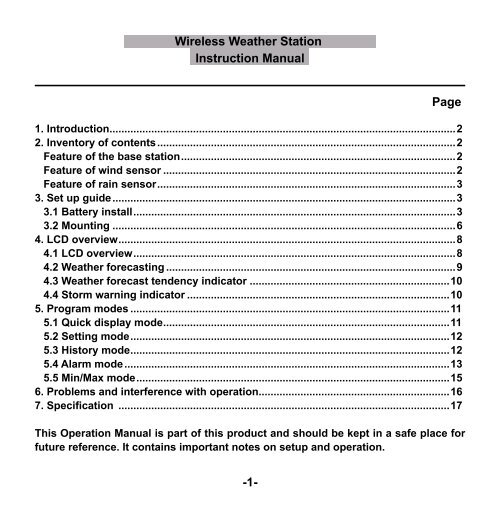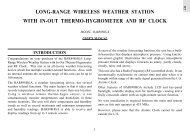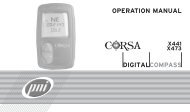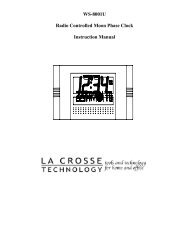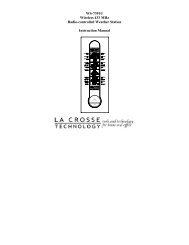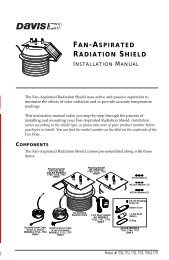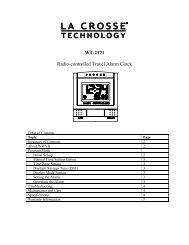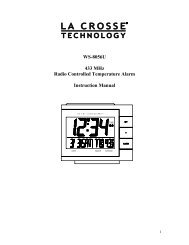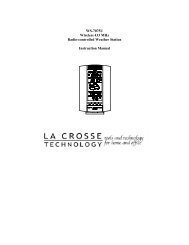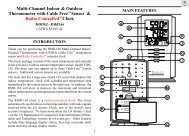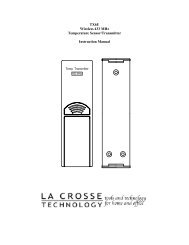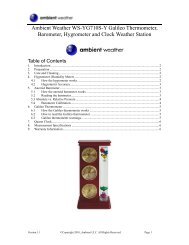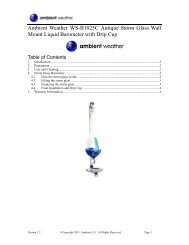Wireless Weather Station Instruction Manual Page - Ambient Weather
Wireless Weather Station Instruction Manual Page - Ambient Weather
Wireless Weather Station Instruction Manual Page - Ambient Weather
Create successful ePaper yourself
Turn your PDF publications into a flip-book with our unique Google optimized e-Paper software.
<strong>Wireless</strong> <strong>Weather</strong> <strong>Station</strong><br />
<strong>Instruction</strong> <strong>Manual</strong><br />
<strong>Page</strong><br />
1. Introduction....................................................................................................................2<br />
2. Inventory of contents.....................................................................................................2<br />
Feature of the base station............................................................................................2<br />
Feature of wind sensor...................................................................................................2<br />
Feature of rain sensor....................................................................................................3<br />
3. Set up guide....................................................................................................................3<br />
3.1 Battery install............................................................................................................3<br />
3.2 Mounting....................................................................................................................6<br />
4. LCD overview.................................................................................................................8<br />
4.1 LCD overview............................................................................................................8<br />
4.2 <strong>Weather</strong> forecasting..................................................................................................9<br />
4.3 <strong>Weather</strong> forecast tendency indicator....................................................................10<br />
4.4 Storm warning indicator.........................................................................................10<br />
5. Program modes............................................................................................................11<br />
5.1 Quick display mode................................................................................................11<br />
5.2 Setting mode...........................................................................................................12<br />
5.3 History mode...........................................................................................................12<br />
5.4 Alarm mode..............................................................................................................13<br />
5.5 Min/Max mode.........................................................................................................15<br />
6. Problems and interference with operation................................................................16<br />
7. Specification ................................................................................................................17<br />
This Operation <strong>Manual</strong> is part of this product and should be kept in a safe place for<br />
future reference. It contains important notes on setup and operation.<br />
--
1. Introduction<br />
Thank you for purchasing this Professional <strong>Weather</strong> Center Designed for everyday use,<br />
the weather station will prove to be an asset of great value for your personal use in the<br />
home or office. Please read this instruction manual thoroughly to fully understand the<br />
correct operation of your weather station and benefit from its unique features.<br />
2. Inventory of contents<br />
1) Base station<br />
2) WH1 sensor including thermo-hygro sensor, rain sensor, wind sensor<br />
3) <strong>Instruction</strong> manual<br />
4)2 adjustable hoops (to fix the mast to your desired location)<br />
The received data is continuously updated to bring you the latest weather information on<br />
the base station’s LCD. The outdoor thermo-hygro sensors is the main data communication<br />
unit since both the wind and rain sensors are connected to the thermo-hygro sensor for<br />
operating power and rely on it to communicate to the base station. <strong>Weather</strong> data sent from<br />
the thermo-hygro sensor is transmitted through wireless link.<br />
Additional equipment (not included)<br />
1. 3 Fresh AA 1.5V LR6 Alkaline batteries.<br />
2. 2 Fresh AA 1.5V LR6 Alkaline batteries.<br />
Feature of the base station:<br />
● Indoor and outdoor temperature display in degrees Fahrenheit or Celsius (user<br />
selectable)<br />
● Indoor and outdoor relative humidity displays<br />
● Barometric pressure reading in inHg or hPa, absolute or relative (user selectable)<br />
● Detailed display of rainfall data in 1 hour, 24 hours, one week, one month and total since<br />
last reset. (user selectable in mm or inch)<br />
● Wind speed in mph, km/h, m/s, knots or Beaufort (user selectable)<br />
● Wind chill temperature display<br />
● Dew point temperature display<br />
--
● <strong>Weather</strong> forecast display by weather icons (sunny, cloudy, rainy)<br />
● <strong>Weather</strong> forecast tendency arrow<br />
● Storm warning alarm<br />
● Display of extensive weather data, in all cases with programmable alarm functions for<br />
certain weather conditions as well as records of all minimum and maximum values along<br />
with time and date of their recordings<br />
● Supper bright green LED back light<br />
● DCF Radio controlled time and date with manual setting option<br />
● 12 or 24 hour time display<br />
● Perpetual calendar<br />
● Time zone setting<br />
● Automatic daylight saving time function based on Germany DST system ( for those users<br />
using the clock outside the time zone of Germany, the DST automatic change time will<br />
be delayed or triggered earlier according to the time zone difference accordingly)<br />
● Wall hanging or free standing<br />
● Synchronized instant reception for outdoor weather data as well as radio controlled time<br />
signal<br />
Features of wind sensor<br />
The wind sensor measures wind speed and sends the data to thermo-hygro sensor, which<br />
in turn transmits the data to the base station.<br />
Feature of rain sensor<br />
The rain sensor measures the rainfall and sends the data to thermo-hygro sensor, which<br />
in turn transmits the data to the base station. Operating power is taken from the thermohygro<br />
sensor by a cable connection<br />
3. Set up Guide<br />
3.1 Battery install<br />
--
Setting up using batteries<br />
LED Indicator<br />
Thermo-hygro Sensor<br />
Sensor Sockets<br />
Battery<br />
Compartment<br />
Battery cover<br />
Note: To avoid operating problems, please take note of battery polarity before/when<br />
inserting any Alkaline Batteries. Use good quality Alkaline Batteries and avoid<br />
rechargeable batteries. Since the radio controlled time receiver is built inside the<br />
sensor, please do not put the sensor close to area with mass metal or obvious<br />
shielding objects around.<br />
1)Pull away the shower proof casing of the thermo-hygro sensor to reveal the two sockets<br />
(for the wind sensor and rain sensor)<br />
2)Connect the attached cables of wind and rain sensors to the corresponding sockets<br />
of the thermo-hygro sensor by clicking them into place. Make sure that rain and wind<br />
sockets not swapped when plugging the phone jacket.<br />
3)Open the base station’s battery cover located at the back of the unit and insert 3 x AA,<br />
1.5V Alkaline batteries into the battery compartment and close the battery cover<br />
4)Open the battery cover of the thermo-hygro sensor located below the two sockets and<br />
insert 2 x AA, 1.5V Alkaline batteries and close the cover<br />
Every time the thermo-hygro sensor is powered up (for example after a change of<br />
batteries), the LED indicator will light up for 4 seconds (if no LED light up or is lighted<br />
permanently, make sure the battery is inserted the correct way or a proper reset is<br />
happened). After the thermo-hygro sensor is powered up, the sensor will transmit weather<br />
--
Note for Radio Controlled Time DCF:<br />
The time and date display is based on the signal provided by the highly accurate<br />
government operated atomic clock. The outdoor sensor will continue to scan for the<br />
radio controlled time signal each day despite it being manually set. If reception has been<br />
unsuccessful, then the radio controlled time icon will not appear but reception will still be<br />
attempted continually. If reception has been successful, the received time and date will<br />
overwrite the manually set time and date.<br />
-data<br />
for 24s, and then the sensor will start radio controlled time reception. During the RCC<br />
time reception period (maximum 5 minutes), no weather data will be transmitted. The LED<br />
indicator will be blinking 5 times once RCC signal was synchronized and the LED indicator<br />
will not light during any future regular RCC reception routines. Regular RF link will be<br />
established once RCC reception routine is finished.<br />
When the base station is powered up, a short beep will sound and all LCD segments<br />
will light up for about 3 seconds before it enters into learning mode to learn the sensors<br />
security code.<br />
Note: DO NOT PRESS ANY KEY during the first 10 minutes learning period or before<br />
radio controlled time is displayed on the receiver. After both outdoor weather data and<br />
radio controlled time are displayed you can place your remote sensor outdoors and set<br />
your time (if no RCC reception is possible). If there is no temperature reading in the indoor<br />
station, make sure the units are within range of each other or repeat the battery installation<br />
procedure. If a key is pressed before the weather station receives the temperature signal,<br />
you will need to follow the battery installation procedure again. Please wait minimum<br />
10seconds before re-insert the battery again to make a proper reset for both<br />
transmitter and receiver.<br />
Note : If a battery change on the transmitter side happened, the base station will be<br />
resynchronized to the transmitter again within the next 3 hours. If you want to shorten the<br />
receiving data time, the base station has to re-install the battery so that it can have the<br />
new security code learnt right way, but the previous weather data and alarm value settings<br />
in base station will be lost.
Note:<br />
When batteries require replacement for the base station, the low battery indicator<br />
will light up on the LCD.<br />
Please participate in the preservation of the environment by properly<br />
disposing of all used-up batteries and accumulators at designated disposal<br />
points. Never dispose of batteries in a fire as this may cause explosion, risk<br />
of fire or leakage of dangerous chemicals and fumes<br />
3.2 Mounting<br />
1) Base station<br />
With one foldable leg at the back of the unit, the base station can be placed onto any flat<br />
surface or wall mounted at the desired location by the hanging holes also at the back of the<br />
unit. It is important to check that outdoor sensor data can be received before permanently<br />
mounting any of the units<br />
2) Remote sensor<br />
For accurate results, the remote sensor mast should be securely mounted onto a<br />
horizontal surface and in an open area away from trees or other coverings where rainfall or<br />
wind speed may be reduced causing inaccurate reading<br />
a). mounting the wind sensor onto a master<br />
Firstly, check that the wind-fan can rotate freely before fixing the unit. The wind sensor<br />
should now be mounted using the screw onto a mast provided to allow the wind to travel<br />
around the sensor unhindered from all directions.<br />
Front<br />
-6-<br />
Back
.) Mounting the rain sensor<br />
c.)Mounting the thermo-hygro sensor same as rain sensor<br />
d.) Fix the whole set to a pole with the two adjustable hoops.<br />
-7-
Once the wind sensor and rain sensor are fixed onto the mast, connect the cable to the<br />
corresponding thermo-hygro sensor socket.<br />
4. LCD overview<br />
4. LCD overview<br />
The following illustration shows the full segments of the LCD for description purposes only<br />
and will not appear like this during normal operation and use.<br />
9<br />
1<br />
30<br />
<br />
6<br />
7<br />
1<br />
13<br />
16<br />
3<br />
4<br />
5<br />
8<br />
9<br />
10<br />
11<br />
14<br />
15<br />
17<br />
18<br />
19<br />
3<br />
4<br />
5<br />
0<br />
1<br />
<br />
6<br />
7<br />
8<br />
-8-
1. Time<br />
2. Alarm on indicator<br />
3. Day of week/ time zone / history<br />
4. Date<br />
5. Indoor temperature display<br />
6. Indoor humidity display<br />
7. Indoor temperature and humidity low<br />
alarm and high alarm<br />
8. Temperature display unit<br />
9. General indoor alarm icon<br />
10. MIN/MAX information<br />
11. Wind chill and dew point<br />
temperature display<br />
12. Outdoor temperature and humidity<br />
display<br />
13. Outdoor temperature and humidity<br />
low alarm and high alarm<br />
14. Temperature display unit<br />
15. General outdoor alarm icon<br />
16. <strong>Weather</strong> forecast icon<br />
17. <strong>Weather</strong> tendency indicator<br />
18. Pressure unit (relative or absolute)<br />
19. Pressure with 24 hour history graph<br />
20. Pressure low alarm and high alarm<br />
21. Pressure display unit (inHg or hPa)<br />
22. Pressure alarm on indicator<br />
23. Wind speed display unit (m/s, km/h,<br />
knots, chill mph, bft)<br />
24. Wind speed high alarm<br />
25. Wind alarm on indicator<br />
26. Rainfall display unit (mm/in)<br />
27. Rainfall 1h, 24h, week, month or total<br />
hour display<br />
28. Rainfall alarm on indicator<br />
29. Radio controlled time version DCF<br />
30. Radio controlled time icon<br />
4.2 <strong>Weather</strong> forecasting<br />
Sunny Partly Cloudy Cloudy Rainy<br />
The four weather icons Sunny, partly Cloudy, Cloudy and Rainy represent the weather<br />
forecasting. For every sudden or significant change in air pressure, the weather icons will<br />
update accordingly to represent the change in weather.<br />
-9-
4.3 <strong>Weather</strong> forecast tendency indicator<br />
The weather tendency indicators arrow is located between the weather icons to show<br />
the air pressure tendency and provide a forecast of the weather to be expected by the<br />
decreasing or increasing air pressure. The rightward arrow means that the air pressure is<br />
increasing and the weather is expected to become better. The leftward arrow means that<br />
the air pressure is decreasing and the weather is expected to become worse.<br />
The change of weather forecast icon is in accord to the relationship between current<br />
relative pressure and the pressure change since last twelve hours. If the weather is<br />
changing, weather tendency indicator (animated arrows) will be flashing. And after the next<br />
three hours if weather conditions have become stable, the arrows will fix indicating a stable<br />
condition happened.<br />
Examples of changing weather icons:<br />
4.4 Storm warning indicator<br />
The storm threshold can be set to suit the user’s requirement for storm forecasting from<br />
3-9hPa (default 4hPa). When there is a fall over pressure threshold within 3 hours, the<br />
storm forecasting will be activated, the clouds with rain icon and tendency arrows will flash<br />
for 3 hours indicating the storm warning feature has been activated.<br />
-0-
Notes to pressure sensitivity setting for weather forecasting:<br />
The pressure threshold can be set to suit the user’s requirement for weather forecasting<br />
from 2-4hPa (default 2hPa). For areas that experience frequent changes in air pressure<br />
requires a higher setting compared to an area where the air pressure is stagnant. For<br />
example if 4hPa is selected, then there must be a fall or rise in air pressure of at least<br />
4hPa before the weather station will register this as a change in weather.<br />
5.Program Mode<br />
The base station has five keys for easy operation: SET key, + key, ALARM key, HISTORY<br />
key and MIN/MAX key. And there are five program modes available: Quick Display Mode,<br />
Setting Mode, Alarm Mode,History Mode and Min/Max Mode.<br />
The program mode can be exited at any time by either pressing the HISTORY key, or<br />
waiting for the 10-second time-out to take effect.<br />
5.1 Quick Display Mode<br />
- While in Normal Mode, press the SET key to enter the Quick Display Mode as follow:<br />
1. Outdoor Temperature / Wind chill / Dew point (press the + key or MIN/MAX key shifts<br />
the display between outdoor temperature, wind chill and dew point)<br />
2. Absolute pressure / Relative pressure (press the + key or MIN/MAX key shifts the<br />
display between the absolute pressure and relative pressure)<br />
3. Wind speed / Gust speed (press the + key or MIN/MAX key shifts the display<br />
between the wind speed and gust speed)<br />
4. 1 hour/ 24 hour / week/ month / total rainfall quantity (press the + key or MIN/MAX<br />
key shifts the display between the selectable rainfall quantities), while display the<br />
rainfall total quantity, pressing the SET key for two seconds will reset the rainfall total<br />
value to zero and the time recording to current time.<br />
- Press the SET key to accept the change and advance to the next display mode.<br />
Continue to press the SET key to toggle through the display mode until return to the<br />
normal Mode<br />
-11-
5.2 Setting Modes<br />
- Press the SET key for 3 second while in normal mode to enter the normal Setting mode<br />
- Press the SET key to select the following setting in sequence :<br />
1.Time Zone Setting<br />
2.12/24 hour format<br />
3.<strong>Manual</strong> time setting (hours/minutes)<br />
4.Calendar setting(year /month/ date, weekday will be calculated thus no need to set<br />
weekday)<br />
5.Temperature display unit degree Celsius or Fahrenheit<br />
6.Air pressure display units in hPa or inHg<br />
7.Relative pressure setting from 919.0hPa – 1080.0hPa (default 1013.2hPa)<br />
8.Pressure threshold setting (default 2hPa)<br />
9.Storm threshold setting (default 4hPa)<br />
10.Wind speed and gust display units in km/h, mph, m/s, knots, bft<br />
11.Rainfall display units in mm or inch<br />
- In the setting modes, press + key or min/max key to select the units or scrolls the value.<br />
Holding the + key or min/max key for 3 second will increase/decrease digits in great<br />
steps.<br />
- Press HISTORY key or key idle 10 second, the setting mode will return to Normal Mode<br />
Note: Please set the units firstly before change units’ value. During change of units setting,<br />
the previous set value will be changed according to the new units. However it might cause<br />
resolution loss due to its internal calculation algorithm.<br />
5.3 History Modes<br />
- While in Normal Mode, press the HISTORY key to enter the History Mode.<br />
- In the History Mode, press the + key to select the record over the past 24hours at<br />
increments of -3 hours,<br />
- -6 hours, -9 hours, -12 hours, -15 hours, -18 hours, -21 hours, -24 hours<br />
- Press the HISTORY key or key idle 10 second to return to Normal Mode<br />
-12-
5.4 Alarm Modes<br />
- While in Normal Mode press the ALARM key to enter the High Alarm Mode<br />
- Press the ALARM key again to enter Low Alarm mode<br />
Remark: after the initial pressing of ALARM key, the display will be refreshed to show<br />
current high, low alarm values. Normal alarm value will be displayed only for those<br />
already activated, all other not activated values will be displayed with “- - -“or “- -“instead.<br />
- Press the ALARM key again to return the Normal Mode<br />
- In the High Alarm Mode press the SET key to select the following alarm modes:<br />
1. Time alarm (at low alarm setting mode, the same time alarm setting sequence will<br />
repeat)<br />
2. Indoor humidity high alarm<br />
3. Indoor temperature high alarm<br />
4. Outdoor humidity high alarm<br />
5. Outdoor temperature high alarm<br />
6. Wind chill high alarm<br />
7. Dew point high alarm<br />
8. Pressure high alarm<br />
9. Wind speed high alarm<br />
10. Gust speed high alarm<br />
11. 1Hour rain high alarm<br />
12. 24 hour rain high alarm<br />
- In the Low Alarm Mode press the SET key to select the following alarm modes:<br />
1.Time alarm (at high alarm setting mode, the same time alarm setting sequence will<br />
repeat)<br />
2. Indoor humidity low alarm<br />
3. Indoor temperature low alarm<br />
4. Outdoor humidity low alarm<br />
5. Outdoor temperature low alarm<br />
6. Wind chill low alarm<br />
7. Dew point low alarm<br />
8. Pressure low alarm<br />
-13-
- In the alarm modes, Press + key to changes or scrolls the value upward, or press min/<br />
max key to change or scrolls the alarm value downward. Hold the + key or min/max key for<br />
3 second to change the number in great step. Press the ALARM key to choose the alarm<br />
on or off (if alarm is enabled, the speaker icon on the LCD will be turned on indicating the<br />
alarm function has been enabled). Press the SET key to toggle through each alarm mode<br />
until it returns to the normal display mode.<br />
- Press HISTORY key or key idle 10 second at any time, the alarm mode will return to<br />
Normal Mode<br />
Canceling the Temperature Alarm While Sounding<br />
a. When a set weather alarm condition has been triggered, that particular alarm will sound<br />
for 120 second and flash until the weather condition doesn’t meet the user set level.<br />
Press any key to mute the alarm. When weather alarm condition was activated again<br />
within 10 minutes, alarm will not sound but will continue to flash until weather conditions<br />
have become more steady. This feature is useful to avoid repeated triggering for the<br />
same alarm value.<br />
b. The alarm will reactivate automatically once the value has fallen below the set value.<br />
The outdoor weather alarm<br />
When a set outdoor weather alarm has been triggered, it will flash on the LCD display and<br />
the general outdoor alarm icon and high/low alarm icon will flash accordingly. For example,<br />
in outdoor temperature display mode, when dew point high alarm is triggered DEW POINT<br />
icon will flash along with general outdoor alarm icon and high alarm icon flashing, telling<br />
that the current alarm source is from dew point.<br />
-14-
5.5 Min/Max Mode<br />
- While in Normal Mode, press the min/max key to enter the maximum mode,<br />
- press min/max key again to enter the minimum mode<br />
- Press min/max key again to return the Normal Mode<br />
- In the maximum reading Mode, press the + key to display the following maximum values<br />
together with the time and date stamp when these values were recorded, if press SET<br />
key in the following individual minimum value will be reset to current reading together<br />
with the current time and date.<br />
1.Indoor humidity maximum<br />
2.Indoor temperature maximum<br />
3.Outdoor humidity maximum<br />
4.Outdoor temperature maximum<br />
5.Wind chill temperature maximum<br />
6.Dew point temperature maximum<br />
7.Pressure maximum<br />
8.Wind speed maximum<br />
9.Gust speed maximum<br />
10.1Hour rain maximum<br />
11.24 hour rain maximum<br />
12.Week rainfall maximum<br />
13.Month rainfall maximum<br />
-In the minimum reading Mode, press the + key to display the following minimum values<br />
together with the time and date at which these values were recorded, if press SET key in<br />
the following individual maximum value will be reset to current reading together with the<br />
current time and date.<br />
1. Indoor humidity minimum<br />
2. Indoor temperature minimum<br />
3. Outdoor humidity minimum<br />
4. Outdoor temperature minimum<br />
5. Wind chill temperature minimum<br />
6. Dew point temperature minimum<br />
7. Pressure minimum<br />
-15-
- Press the HISTORY key or key idle 10 second, the Min/Max mode will return to Normal<br />
Mode<br />
6.Problems and interference with operation<br />
Problem & cause<br />
Distance between transmitters and<br />
receiver too long<br />
High shielding materials between<br />
the units (thick walls, steel, concrete,<br />
isolating aluminum foil and etc.)<br />
Interference from other sources (e.g.<br />
wireless radio, headset, speaker, etc.<br />
operating on the same frequency)<br />
No reception after adding extension<br />
cables<br />
Poor contrast LCD or no reception or<br />
low batteries in sensors or receiver<br />
Temperature, humidity, or air pressure<br />
is incorrect.<br />
Remedy<br />
Reduce distance between transmitters and<br />
receiver to receive signal<br />
Find a different location for sensors and/or<br />
receiver. See also item ‘transmission range’<br />
below<br />
Find a different location for the sensors and/<br />
or base station. Neighbors using electrical<br />
devices operation on the same signal<br />
frequency can also cause interference with<br />
reception<br />
Find a new location for the sensors and/or<br />
base station.<br />
Change batteries<br />
Check/replace batteries. If multiple remote<br />
sensors are in use, check location with<br />
corresponding “boxed numbers”. Or move<br />
away from sources of heat/cold. Adjust<br />
relative air pressure to a value from a<br />
reliable source (TV radio, etc.).<br />
-16-
7. Specifications<br />
Outdoor data<br />
Transmission distance in open field<br />
Frequency<br />
: 150meter max.<br />
: 433MHz or 868MHz (selected by solder option)<br />
Temperature range<br />
: -40℃ to +65℃ (show OFL if outside range)<br />
Resolution : 0.1℃<br />
Measuring range rel. humidity<br />
: 1%~99%<br />
Rain volume display<br />
: 0 - 9999mm (show OFL if outside range)<br />
Resolution<br />
: 0.3mm (if rain volume < 1000mm)<br />
1mm (if rain volume > 1000mm)<br />
Wind speed<br />
: 0~180km/h (show OFL if outside range)<br />
Measuring interval thermo-hygro sensor<br />
Water proof level<br />
: 48 sec<br />
: IPX3<br />
Indoor data<br />
Pressure / temperature<br />
: 48 sec<br />
Indoor temperature measure range : 0℃ to +60℃ (reading range: -20℃ to +65℃)<br />
Resolution : 0.1℃<br />
Measuring range rel. humidity<br />
: 1%~99%<br />
Resolution : 1%<br />
Measuring range air pressure<br />
: 919hPa – 1080hPa<br />
Resolution/Accuracy<br />
: 0.1hPa / 1.5hPa<br />
Alarm duration<br />
: 120 sec<br />
Power consumption<br />
Base station<br />
Remote sensor<br />
Battery life<br />
: 3XAA 1.5V LR6 Alkaline batteries<br />
: 2xAA 1.5V LR03 Alkaline batteries<br />
: Minimum 12 months for base station<br />
Minimum 24 months for thermo-hygro sensor<br />
-7-


